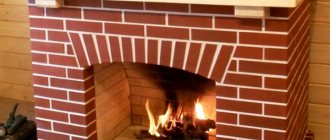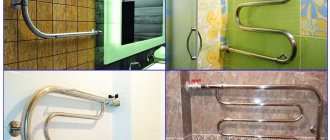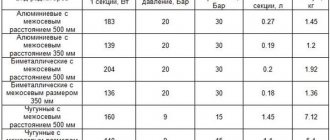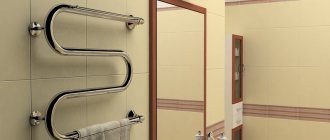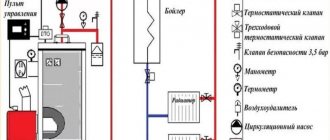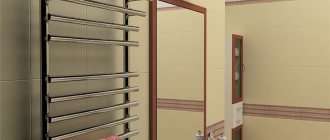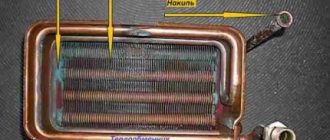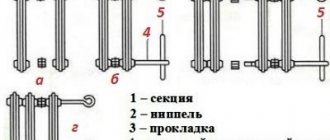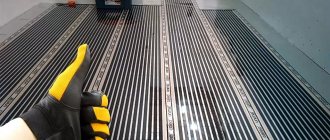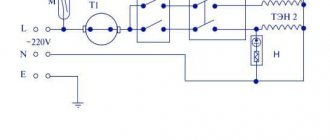High humidity and poor ventilation lead to mold on bathrobes, towels and bathroom trim. To dry things and air in the room, you can use a heated towel rail - a device that is connected to the mains or water coolant.
Most often, the device is installed in a hot water supply or heating riser, so in order to avoid accidents, you must strictly follow the rules for installing a heated towel rail.
Connecting a heated towel rail: DHW or heating
Before installing a water heated towel rail in the bathroom, you need to decide on the method of connecting it.
Two options are available:
- Connection to the DHW system . The method guarantees year-round heating. The device heats up when hot water is consumed - the heated towel rail cools down overnight even when turned on directly through the riser.
- Connection to the heating system . This option is relevant in the absence of a centralized hot water supply network. Thanks to the forced circulation of the coolant, the coil remains warm around the clock. The disadvantage is that the dryer functions only in the cold season.
When replacing a heated towel rail in an apartment building with a change in the way it is connected, a project will need to be developed and approved by the housing and communal services department. It will take about a month to complete the package of documents.
The insertion points of the water device into the heating or hot water riser can be hidden behind a screen or box constructed from plasterboard
Types of heated towel rails
Based on the type of coolant, towel dryers are classified into:
- Mermen. These devices are connected to the hot water or heating riser. The metal pipe serves both as a rack for drying items and as a conductor of hot water. The advantage of water heated towel rails is minimal heating costs, but the disadvantage is the high risk of flooding if connected incorrectly.
- Electrical. They are mounted close to the outlet and connected to the network. The advantage of the device is that it can be connected to the network without interfering with the water supply system. Its main disadvantage is its high energy consumption: the specific power of an electric coil per 1 square meter of a bathroom is 150-160 W, which corresponds to 0.6-1 kW for an average bathroom.
- Combined. They consist of two working frames. One of the surfaces heats up when hot water passes through, and the second - when the electric heat element (TEH) heats up. Many combination instruments are equipped with a rotating inner frame.
Depending on the shape, heated towel rails are divided into the following types:
- bracket (U-shaped);
- coil (M-shaped);
- "Ladder";
- “Foxtrot” (bracket with internal coil);
- “Modern” (staircase with offset supports and lintels).
The size and shape of the device are selected depending on the design of the room and the volume of heated air. Heaters such as “Ladder”, “Foxtrot” and “Modern” are suitable for a spacious bathroom, and brackets and coils are suitable for a small bathroom.
The towel rail can be made from brass, copper, carbon steel or stainless steel. The steel surface is protected by chrome plating. The type of device is selected depending on the design of the bathroom and the material from which the riser is made.
To avoid the formation of a galvanic couple, which leads to rust, a dryer made of the same material is connected to the metal pipe. Polypropylene (plastic) riser allows the use of any material.
General installation requirements
Installation of a heated towel rail with a “water” operating principle is carried out subject to a number of conditions:
№1. The diameter of the pipes of the device must correspond to the diameter of the riser; narrowing from the installed fittings is unacceptable.
№2. A jumper must be provided between the drying outlets. The bypass performs a number of tasks:
- maintaining the speed of water circulation throughout the riser;
- separation of coolant flows allows you to save heat for subsequent water intake points;
A significant advantage of turning on the closing sections, bypasses, is the ability to turn off the heated towel rail for repairs without stopping the operation of the system as a whole.
№3. It is prohibited to install shut-off valves on the pipeline section up to the bypass and directly on the jumper.
Failure to comply with the requirement entails:
- slowdown of water circulation through the riser and drop in coolant temperature;
- deterioration of pressure in apartments located in the direction of water supply.
The closing sections can be equipped with the usual ball valves on the bypass and supply line or with more functional three-way valves that allow the coolant to be directed either to the bypass or to the radiator.
№4. The recommended height for placing towel dryers according to SNiP is 120 cm from the floor.
№5. Maximum distances between the heating device and wall cladding:
- 3.5-4 cm – if the coil diameter is 2.5 cm or less;
- 5-7 cm – for pipe cross-sections larger than 2.5 cm.
If a bypass is provided in the installation diagram, then it is permissible to install shut-off ball valves at the outlet and inlet of the device.
Using a bypass in a heating circuit allows you to divide the total coolant flow into two parts. One of the parts goes into the battery, the other is supplied to the following devices, due to which all radiators receive coolant at almost the same temperature as the first (+)
general information
With the adoption of SNiP 2.04.01‑85 , in which the term “towel rail” appeared, the device soon came into general use.
Unaesthetically pleasing and, moreover, useless at the end of the heating season, iron structures painted with “silver” or nitro paint, nevertheless appealed to the taste of householders, and soon they began, by hook or by crook, to obtain and install
nickel-plated, graceful, elegant and practical European units.
This topic has not lost its relevance even now: in the housing stock there are still many old buildings, where apartment owners, starting repairs or replacement of plumbing equipment, turn their attention to such useful and necessary devices for equipping a bathroom, which are quite within the capabilities of a home handyman. self-installation .
Recommended and unacceptable insertion schemes
The operation of the coil is based on the principle of a “gravity pump”. Proper insertion ensures natural circulation and functionality of the radiator. The development of a do-it-yourself installation diagram for a water heated towel rail is carried out in accordance with the design of a specific model and the location of the riser in the bathroom.
Lateral and diagonal connection
For most devices, the optimal option is a connection with coolant supply through the top outlet and outlet from the bottom. This is achieved with universal connections, the diagrams of which are given below.
Lateral and diagonal connections without narrowing or shifting the bypass are equivalent options. The circuits function well with coils of different shapes (+)
Advantages of a universal insert:
- performance does not depend on the direction and speed of water supply in the riser;
- after turning off the circulation, bleeding of air is not required;
The universal insertion option allows you to place the heated towel rail at any convenient installation distance from the riser.
Conditions for the operation of the scheme:
- The lower insertion point is located below the connection pipe to the radiator, and the upper insertion, accordingly, is above the upper outlet. The slope of the supply pipes is 2-3 cm per meter. A horizontal connection is permissible for pipes with a cross-section of 32 mm, and also if the distance to the riser is less than 2 m.
- Supply pipes - without bends or humps. Otherwise, the system becomes airy and natural circulation stops.
- Optimal diameter of supply pipes: ¾ inch steel, 25 mm – reinforced polypropylene.
- It is advisable to insulate the pipes. This requirement is especially relevant for hidden installation of a plastic pipeline.
A completely workable side/diagonal insertion scheme with a narrowed bypass. Plumbers resort to this design on a previously installed heated towel rail if there is no need to completely change the design of the riser.
Between the leads to the device, the jumper is narrowed by one diameter size. The insertion option is only suitable for water circulation in the direction from top to bottom
Shifting the bypass is justified if you want to preserve the old connections to the riser. With this connection method, it is not recommended to use a narrowed jumper. The main requirement is the top supply of coolant.
Tolerances and installation requirements for tapping with an offset bypass are the same as for lateral or diagonal connection with a flat jumper (+)
Some dryer models are designed for bottom connection. The insertion is carried out according to three main schemes.
The circuits are operational in any direction of coolant flow. When the water is turned off, the system is aired out, so a drain valve must be located on the vertical manifold. As a rule, it is included with the device (+)
Requirements for implementing the bottom connection:
- The lower outlet must be located below the heated towel rail.
- It is advisable to insulate the supply pipes.
- The upper outlet of the riser when using an offset or narrowed bypass is located below the point of connection to the device.
The optimal slope is about 2 cm per meter of pipe. Fulfillment of this condition ensures that the circuit is independent of the direction of water flow.
Possible forced insertion options
When connecting laterally, some deviations from typical recommended circuits are allowed.
Pipe routing if a non-standard location of the liner is required. The operation of the device is equally effective in different directions of the coolant (+)
The basic conditions of the tie-in remain unchanged. The difference is in the connection points between the heated towel rail and the riser, as well as in the presence of vertical sections at the inlet and outlet of the device.
An alternative sidebar option is shown below. The top of the heated towel rail is located above the top outlet. After turning off the water, you will need to bleed the air from the coil.
The connection diagram requires the installation of an air vent on the device. Due to the design “step”, when the water supply is stopped, an air lock is formed in the system (+)
The lower inset may also be somewhat modified. The need to place pipes from the riser at a minimum distance to the floor forces us to increase both ascending connections. If all requirements for the lower connection are met, the system operates without failure.
The requirements for installation work when inserting with extended vertical sections of the lower line do not change. Different directions of water circulation are allowed (+)
Incorrect connection diagrams
Inexperienced craftsmen sometimes do not adhere to the recommended schemes. As a result, the dryer remains cold with an uninterrupted supply of hot water. Examples of possible omissions are displayed below.
Incorrect execution of the side and bottom inserts leads to a stop in the water circulation in the heated towel rail (+)
In both options, the device is located below the lower outlet from the riser. The coolant that sinks down cools and becomes trapped. The water is not pushed back, since there is pressure from the coolant flow from above.
Side cut with a loop at the top. The scheme is implemented by craftsmen in order to hide communications behind the suspended ceiling
Air accumulates in the resulting “hump.” Over time, the air lock blocks the circulation in the radiator and the heated towel rail cools down.
The option presented below combines two errors at the same time. The scheme is obviously not working.
The combination of the lower and upper threshold impedes natural circulation. This design is typical when craftsmen try to hide the upper supply behind the ceiling, and the lower one in the floor screed
Device selection
All designs of these units are divided into three types:
- Mermen.
- Electrical.
- Combined.
When replacing an old device with a new one, it is most logical to use a water type . Electrical devices are used where there is neither a centralized heating system nor hot water supply, or as a backup during shutdowns.
The external design of water devices is quite diverse:
- 1st type : M‑, U‑, F‑shaped - traditional shapes.
- 2nd type : “ladders”, “snakes” and other types of original design of modern devices.
To include them in the existing system, the location of the installation pipes is also important :
- Lateral - usually used for type 1 devices;
- Bottom or top - more common among type 2 devices.
The choice of the appropriate option is determined by the availability of free space in the bathroom, the location of the piping system and the type of connection diagram. More details about which water heated towel rail is best to choose are in this article.
Step-by-step installation of a water heated towel rail
The technology for installing a water heated towel rail with your own hands is the same for different connection schemes. The step-by-step progress of work includes dismantling the worn-out device, supplying pipes from the riser, installing taps and fastening the coil.
Preparation of tools and materials
The set of tools required to install and replace a heated towel rail depends on the type of water pipes in the room. For installation through polypropylene pipes you will need: ball valves; mounting brackets; polypropylene pipes; soldering iron and knife for cutting PP pipes.
The standard equipment of the heated towel rail includes:
- transition corners;
- silicone gaskets;
- locking units;
- telescopic brackets;
- Mayevsky crane.
It is advisable to use components from the same metal in the system to avoid electrolytic corrosion.
All connections are sealed with gaskets, threaded detachable units are sealed with plumbing tape (+)
Dismantling of old equipment
Before dismantling the outdated coil, it is necessary to coordinate the actions with the house management organization. Disconnecting the riser from the water requires special permission.
Following actions:
- If the towel dryer is not integral with the hot main, then the threaded connections must simply be unscrewed.
- If the device is welded to the riser, then it should be cut off with a grinder. The remaining portion of the pipe connection should be sufficient for threading.
- Remove the used device from the brackets.
The height of the cutout in the riser must exceed the distance between the pipes of the new device by the length of the couplings and bends required for inserting the bypass jumper
The size of the dismantled area must be determined with maximum accuracy. It’s better not to cut a little, and after “trying on” the device to the installation site, adjust it after the fact
Installation of bypass and ball valves
The coil can be mounted without installing a bypass, but experts recommend providing a jumper in advance. Ball valves are installed at the ends of the heated towel rail. If necessary, the coolant supply to the device can be shut off, while water will circulate freely through the riser.
The bypass is inserted into a riser made of PP pipe using tees and couplings (+)
To install valves on pipe sections, cut a new thread using a die of the required diameter. If after dismantling the old device the thread has survived, then it is enough to “drive” it with a die to improve the connection. Install shut-off valves on the prepared pipes.
Installation of the jumper in the steel pipeline is carried out by welding. The bypass diameter is equal to the cross-section of the riser pipe
Attaching the heated towel rail coil
The procedure for “hanging” and connecting the device is as follows:
- Apply markings on the wall for the brackets - it is necessary to ensure that the placement of the coil is horizontal.
- Prepare the holes and insert dowels into them.
- Screw the brackets to the heated towel rail, place the device against the wall and secure with screws. It is important to adhere to the recommended distance between the radiator and the wall cladding.
- Connect the unit to the valves on the jumper using fittings, seal the connections with linen wrap.
Depending on the type of connection, straight or angled threaded fittings are used.
At the end of installation, inspect the tightness of the joints and smoothly open the taps to check the functionality of the device. There should be no leaks or drops
How the coil is attached
Installation of the heated towel rail step by step with all fittings is as follows.
- Markings are applied to the working wall in order to install the brackets evenly.
- Holes for dowels are prepared according to the markings.
- The next step is to attach all the brackets to the dryer, and then screw them to the work area using screws.
- The final step is to connect the device to the necessary valves using fittings. All connections must be sealed with linen winding.
If you are installing a heated towel rail in the bathroom with your own hands, then it is worth considering that straight and corner fittings can be used, depending on what type of connection is used in this case.
Features of installation of electric models
Unlike water models, electric dryers can be installed anywhere, since they do not depend on the location of heating pipes and hot water supply. In this case, special attention should be paid to the quality of the electrical wiring.
Requirements for installation of electric heated towel rails:
- The installation location is selected taking into account the level of protection of the device from moisture. The distance to the bathroom or washbasin is at least 60 cm.
- The minimum distance to the floor is 20 cm, to the wall – 30 cm, to the surface of furniture – 75 cm.
- The heating device must not be placed directly under the outlet.
Connection to the electrical network is carried out in accordance with the international standard NFC-15-100.
The optimal location is zone No. 3. When installed in zone No. 2, protection of the device from splashes is required (+)
Electrical wiring under the heated towel rail is carried out in compliance with electrical safety standards in rooms with high humidity:
- connection via a three-wire cable with grounding;
- Only hidden electrical wiring is allowed;
- the socket must have a rubber seal and a cover covering the contact holes;
- Copper wires of the VVGng and VVGng-LS brands are used for the electrical network.
A prerequisite for the installation and operation of electrical appliances is the use of an RCD that turns off the device when the current operating characteristics are exceeded.
Oil heated towel rails require rigid fixation, while cable radiators can be installed in any position
Main stages of installation
At the first stage of installing the device, it is necessary to dismantle the old dryer. Then the pipes are soldered. As mentioned above, for the dryer to operate, you need to install 2 taps. The next step is to install a bypass. The technology is described above. After this, you can begin installing and adjusting new equipment. At the very last stage of installation, it is important to check the components of the pipeline and drying device. It is advisable to entrust all the work to a plumber. In this case, the first step is to draw up an estimate of the work. It must include the cost of materials, stages of work, and the cost of additional work. After which you need to write an application to the housing and communal services to shut off the water. After setting a date, you can negotiate with the master about working hours.
To properly install a towel dryer, you need to know that on drying devices connected to independent heating systems, you need to make a shut-off valve in order to turn it off during the warm season. The connection to the hot water pipeline is made using couplings. The slopes of the liner are made in the direction of water movement. They must be at least 5 and no more than 10 mm throughout. It is advisable to connect the riser above the heated towel rail so that the water flows from top to bottom at a slope.
Related article: Drainage system around the house: how to make foundation drainage with your own hands, video
A towel dryer is a fairly simple device, but its installation requires the involvement of specialists.
Armature
To install a heated towel rail, you will need ball valves with an “American” type - a built-in drain. They are connected to polypropylene pipes using couplings with internal threads.
If the ball valve is of a conventional design, a transition from a PPR coupling with thread and a brass “American” is used. Combined plastic and brass leads are not recommended. When the temperature fluctuates, they often leak.
In systems with natural circulation without displacement and/or narrowing of the bypass, 3/4-inch water outlets are installed. It is better to replace eccentrics with nipples or barrels of the same diameter.
